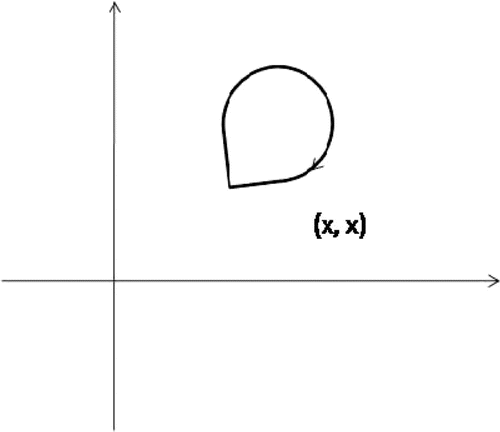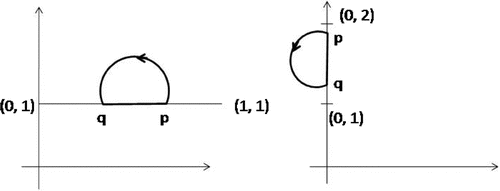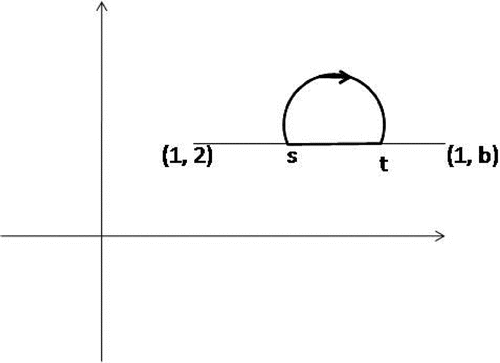 ?Mathematical formulae have been encoded as MathML and are displayed in this HTML version using MathJax in order to improve their display. Uncheck the box to turn MathJax off. This feature requires Javascript. Click on a formula to zoom.
?Mathematical formulae have been encoded as MathML and are displayed in this HTML version using MathJax in order to improve their display. Uncheck the box to turn MathJax off. This feature requires Javascript. Click on a formula to zoom.Abstract
In this paper we define a generalized proximal G-contraction on a metric space having the additional structure of a directed graph. We obtain a best proximity point result for such contractions which is with a view to obtaining minimum distance between the domain and range sets. An example illustrating the main theorem is also discussed. The work is in the line of research on mathematical analysis as well as optimization in metric spaces with a graph.
Public Interest Statement
In this paper some results of mathematical analysis are established. It is a core area of mathematics on which stands a large part of the theoretical development of mathematics as well as many applications of mathematics. Particularly the results are in the domain of fixed point theory which is an extensive branch of mathematics having overlapping with various branches of pure and applied mathematics. The theory has also important implications in computer science. Although the present results are theoretical, there are potential applications of similar results in the literature. A noticeable aspect of the present work is the development of algorithm.
1. Introduction and mathematical preliminaries
The purpose of this paper is to establish a best proximity point theorem for generalized rational proximal contractions. It is a study on metric spaces with the additional structure of a graph on it. We begin with the following technical details which are necessary for the discussion in the paper.
Throughout the paper denotes a metric space and
. We use the following notations.
It is to be noted that if is a nonempty, weakly compact and convex pair in a Banach space X, then
and
are nonempty (Basha & Veeramani, Citation2000; Gabeleh, Citation2015).
Definition 1.1
[P-property (Sankar Raj, Citation2011)] Let A and B be two nonempty subsets of a metric space with
. Then the pair
is said to have the P-property if for any
and
,
Abkar and Gabeleh (Citation2012) have shown that every nonempty, bounded, closed and convex pair of subsets of a uniformly convex Banach space has the P-property. Some nontrivial examples of nonempty pairs of subsets which satisfy the P-property are given in Abkar and Gabeleh (Citation2012).
Lemma 1.1
(Gabeleh, Citation2013) Let be a pair of nonempty closed subsets of a complete metric space
such that
is nonempty and
has the P-property. Then
is a closed pair of subsets of X.
Definition 1.2
An element is said to be a best proximity point the mapping
if
.
Let . Let
be a directed graph such that its vertex set V(G) coincides with X, that is,
and the edge set E(G) contains all loops, that is,
. Assume that G has no parallel edges. By
we denote the conversion of a graph G, that is, the graph obtained from G by reversing the directions of the edges. Thus we have
Let denote the undirected graph obtained from G by ignoring the directions of edges. Actually, it is convenient for us to treat
as a directed graph for which the set of its edges is symmetric. Under this convention,
A graph is called a subgraph of the graph
if
and
. If
, then
denotes the subgraph of graph G, where
.
Definition 1.3
If x and y are vertices in a graph G, then a path in G from x to y of length is a sequence
of
vertices such that
and
for
.
A graph G is connected if there is a path between any two vertices. G is weakly connected if is connected.
Let G be such that E(G) is symmetric and x is a vertex in G, then the subgraph consisting of all edges and vertices which are contained in some path beginning at x is called the component of G containing x. In this case
, where
is the equivalence class of the relation R defined on V(G) by the rule: yRz whenever there is a path in G from y to z.
We say a metric space is endowed with a directed graph G, if G is a directed graph such that
and
. We suppose that
is metric space endowed with a directed graph G.
Definition 1.4
Let be a mapping. Then
and
are defined as follows:
Definition 1.5
A mapping is a Banach type proximal G- contraction if for all
with
and
, the followings are satisfied.
| (i) |
| ||||
| (ii) |
| ||||
Definition 1.6
A mapping is a generalized proximal G- contraction if for all
with
and
the followings are satisfied.
| (i) |
| ||||
| (ii) |
| ||||
Definition 1.7
A mapping is a generalized proximal G- contraction on
if for all
with
the followings are satisfied.
| (i) |
| ||||
| (ii) |
| ||||
Definition 1.8
The triple is said to be regular if
| (i) | For any sequence | ||||
| (ii) | For any sequence | ||||
As stated earlier, our purpose is to establish best proximity point results. Best proximity points are associated with non-self maps defined from one subset of a metric space to another. They are studied for the purpose of obtaining minimum distance between two sets. There are two aspects of this problem. Primarily, it is a global minimization problem where the quantity is minimized over
subject to the condition that the minimum value is
. When this global minimum is attained at a point z, then we have a best proximity point for which
. Another aspect is that it is an extension of the idea of fixed point to which it reduces in the cases where
is nonempty. This is illustrated through the following. Let
and
be two subsets of
with the usual metric
. Let
be a mapping such that
. Then
. So that 0 is a best proximity point of the mapping S. This is not a fixed point of S. In fact fixed point of the non-self map S does not exist.
On the contrary if , then the mapping
given by
has a best proximity point which is also a fixed point.
In fact fixed points are best proximity points, but the converse is not true. The above is the reason for which fixed point methodologies are applicable to this category of problems. More elaborately, the problem can be treated as that of finding a global optimal approximate solution of the fixed point equation even when the exact solution is nonexistent for
which is the case of interest here. We adopt the later approach in this paper.
Metric spaces with the structure of graph have been considered in recent times especially in the context of fixed point theory of contractive type mappings. The line of research was originated in the work of Jachymski (Citation2008) and was further pursued in Abbas, Nazir, Lampert, and Radenović (Citation2016), Beg, Butt, and Radojević (Citation2010), Bojor (Citation2012), Eshi, Das, and Debnath (Citation2016), Kumam, Salimi, and Vetro (Citation2014), Tiammee and Suantai (Citation2014), Shukla (Citation2014). The essential feature of these works is that the metric inequality for the purpose of ensuring the fixed point need only be satisfied on certain pairs of points which are, in this case, connected by the edges of the graph. It is a further extension of metric spaces with a partial order structure on it.
In this paper, against the above background, we establish a best proximity point theorem in a metric space having a structure of graph defined on it by using generalized proximal G-contractions. In the last section we discuss an illustrative example.
2. Main results
Theorem 2.1
Let be a complete metric space endowed with a directed graph G. Let
be a pair of nonempty and closed subsets of X such that
is nonempty and closed. Let
be a mapping with the properties that
and S is generalized proximal G- contraction on
. Suppose that (a) S is continuous or (b) the triple
is regular. Then the the following statements hold:
| (1) | For any | ||||
| (2) | If | ||||
| (3) | If | ||||
| (4) |
| ||||
Proof
| (1) | It follows from the definition of | ||||
and(2.2)
(2.2)
Now, for all we have
,
and
. Since S is generalized proximal G- contraction on
, we have
(2.3)
(2.3)
where
Suppose that , for some positive integer n. Then
. Then it follows from (2.3) that
which is a contradiction. Therefore,(2.4)
(2.4)
Hence we have from (2.3) and (2.4) that(2.5)
(2.5)
By repeated application of (2.5), we have(2.6)
(2.6)
For arbitrary with
,
Therefore, is a Cauchy sequence in
. Since
is a closed subset of complete metric space
, there exists
such that
(2.7)
(2.7)
Suppose that S is continuous. Taking
in (2.2) and using the continuity of S, we have
; that is, z is a best proximity point of S.
Next we suppose that the triple
is regular. By (2.1) and (2.7), we have
(2.8)
(2.8) Now
and
imply the existence of a point
for which
(2.9)
(2.9)
Since S is generalized proximal G- contraction on , we have
(2.10)
(2.10)
where
Using (2.7), we have(2.11)
(2.11)
Taking the limit as in (2.10), using (2.7) and (2.11), we have
, which is a contradiction unless
; that is,
. Then by (2.9) we have that
; that is, z is a best proximity point of S. By (2.8), it is obvious that
and so
. Hence S has best proximity point in
.
| (2) | Let | ||||
| (3) | Let | ||||
| (4) | Let | ||||
With the help of P - property we have the following theorem which is obtained by an application of Theorem 2.1.
Theorem 2.2
Let be a complete metric space endowed with a directed graph G. Let
be a pair of nonempty and closed subsets of X such that
is nonempty and
satisfies the P-property. Let
be a mapping with
. Suppose that for all
with
the followings are satisfied.
| (i) |
| ||||
| (ii) |
| ||||
| (1) | For any | ||||
| (2) | If | ||||
| (3) | If | ||||
| (4) |
| ||||
Proof
By Lemma 1.1, is nonempty and closed. Since
satisfies P-property,
and
imply that
. Then condition (ii) of the theorem reduces to the following inequality
, where
and
Hence S is generalized proximal G-contraction on . Therefore, we have the required proof from that of Theorem 2.1.
3. Example
Example 3.1
Let (R denotes the set of real numbers) and d be a metric on X defined as
. Let
and
, where
,
,
and
. Let G be a directed graph with
and
where
and
Let
and
Let be defined as
Let be such that
. The function S satisfies all the postulates of Theorems 2.1. The set of best proximity points of the mapping S, that is, Prox (S) is nonempty. Here
(Figures –).
Additional information
Funding
Notes on contributors
Binayak S. Choudhury
Binayak S. Choudhury is Professor of Mathematics in IIEST, Shibpur, Howrah, 711103, West Bengal, India, since 2003. He has supervised several PhD students in different areas of pure and applied mathematics and theoretical physics and has published a good number of research articles in international journals. Particularly he has published more than 100 research articles in metric space related studies. He has served his institute in several administrative capacities.
Nikhilesh Metiya
Nikhilesh Metiya is an assistant professor in the Department of Mathematics, Sovarani Memorial College, Jagatballavpur, Howrah-711408, West Bengal, India. He got his PhD from IIEST (Formerly BESUS), Shibpur, Howrah, 711103, West Bengal, India, in 2013. He has 32 international publications in fixed point theory and allied subjects. His research interests include with mathematical analysis, nonlinear analysis and optimization.
References
- Abbas, M., Nazir, T., Lampert, T. A., & Radenović, S. (2016). Common fixed points of set-valued F-contraction mappings on domain of sets endowed with directed graph. Computational and Applied Mathematics. doi:10.1007/s40314-016-0314-z
- Abkar, A., & Gabeleh, M. (2012). Global optimal solutions of noncyclic mappings in metric spaces. Journal of Optimization Theory and Applications, 153, 298–305.
- Basha, S. S., & Veeramani, P. (2000). Best proximity pair theorems for multi functions with open fibres. Journal of Approximation Theory, 103, 119–129.
- Beg, I., Butt, A. R., & Radojević, S. (2010). The contraction principle for set valued mappings on a metric space with a graph. Computers & Mathematics with Applications, 60, 1214–1219.
- Bojor, F. (2012). Fixed point theorems for Reich type contractions on metric spaces with a graph. Nonlinear Analysis, 75, 3895–3901.
- Eshi, D., Das, P. K., & Debnath, P. (2016). Coupled coincidence and coupled common fixed point theorems on a metric space with a graph. Fixed Point Theory and Applications, 2016, 37.
- Gabeleh, M. (2013). Proximal weakly contractive and proximal nonexpansive non-self-mappings in metric and Banach spaces. Journal of Optimization Theory and Applications, 158, 615–625.
- Gabeleh, M. (2015). Best proximity point pheorems via proximal non-self mappings. Journal of Optimization Theory and Applications, 164, 565–576.
- Jachymski, J. (2008). The contraction principle for mappings on a metric space with a graph. Proceedings of the American Mathematical Society, 136, 1359–1373.
- Kumam, P., Salimi, P., & Vetro, C. (2014). Best proximity point results for modified α-proximal C-contraction mappings. Fixed Point Theory and Applications, 2014, 99.
- Sankar Raj, V. (2011). A best proximity point theorem for weakly contractive non-self-mappings. Nonlinear Analysis, 74, 4804–4808.
- Shukla, S. (2014). Reich type contractions on cone rectangular metric spaces endowed with a graph. Theory and Applications of Mathematics and Computer Science, 4, 14–25.
- Tiammee, J., & Suantai, S. (2014). Coincidence point theorems for graph-preserving multi-valued mappings. Fixed Point Theory and Applications, 2014, 70.



